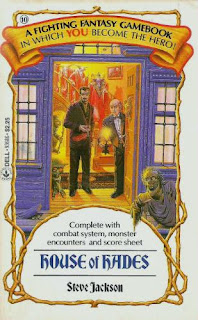Although his artwork later appeared on the cover for The Citadel of Chaos, House of Hell was Ian Miller’s first work for the Fighting Fantasy series.
“I got the job through the art agency Young Artists, which
is now known as Arena,” Miller told Alex Ballingall when he was interviewed for
the Fighting Fantazine in 2012. “I did a series of roughs, four I think, and
Steve chose the version he liked best. It was an easy process.
“When I did cover work (I’m not often asked these days), I
worked maybe one or two up on the published book size. The image would be
penciled in, then inked and coloured. I used Illustration board for the most
part… I always read the books I did covers for. It made sense in my opinion… I
think the first, House of Hell, was
the best of the bunch.”
Steve Jackson was so impressed by Miller’s work on House of Hell that he purchased the
original painting.
The book was illustrated internally by Tim Sell. However, one
of his illustrations was removed from subsequent printings after a number of complaints
were received by Puffin Books.
“That did give us a problem,” recalls editor Philippa Dickinson. “We had a lot of complaints. The media suddenly got hold of, ‘was this suitable for children?’ We had various, no doubt very well-meaning people, claiming that we were encouraging children to believe in Satan and Satanism... I do remember one of the people who was interviewed for television said that her child had come out with the mark of the Devil on his body and when she threw the book into the fire the marks on his body disappeared.
“It was of that time, and it was because the books were so
successful, and boys were getting so obsessed, so what were we doing? They were
being obsessed by something, so this can’t be healthy, because they’re
obsessed. But they’re reading! What are you complaining about?"
“In the middle of all of this craze, and all of the people
saying that we were corrupting children, we also had as many, if not more
people saying, ‘Thank God! My son is finally reading.’" says Dickinson. "Boys were
reading because they saw it as a game, not a book. They were reading because
everybody else was doing it.”
This wasn’t the only time that Fighting Fantasy courted
controversy. The FF series has had its fair share of vehemently outspoken
enemies in the UK.
“The Evangelical Alliance published an eight page warning
guide about the potential danger of reading Fighting Fantasy leading to devil
worship!” says a clearly stunned Livingstone. “And a worried housewife in
deepest suburbia reportedly said on radio that after having read one of my
books, her son levitated. Kids thought, ‘Great – for £1.25 I can fly!’ This was
all wonderful PR for Fighting Fantasy.”
Did you know...?
The dedication written by Steve Jackson for the Wizard Books
edition of House of Hell reads:
Games Night —
to Clive, Ian, Mark, Peter and Skye.
May their Dinner Winnerships be few.
But always more than mine...
The list of names are the members of an exclusive gaming group that’s been running since the mid-1990s, and which includes Peter Molyneux of Lionhead Studios fame among its membership. Games Night is still a regular event, and at the end of each season a cup is awarded.







No comments:
Post a Comment